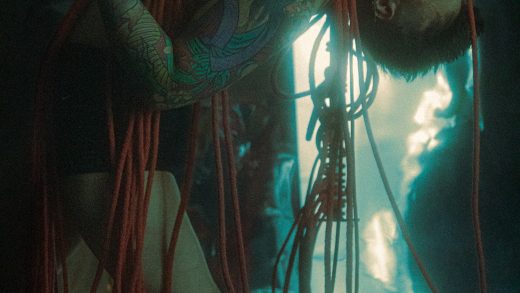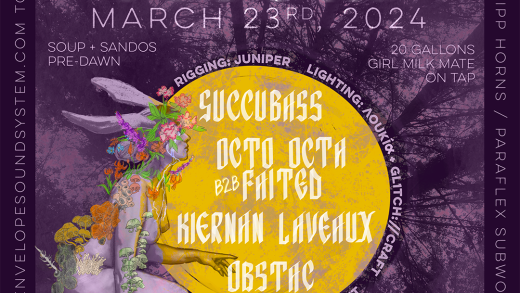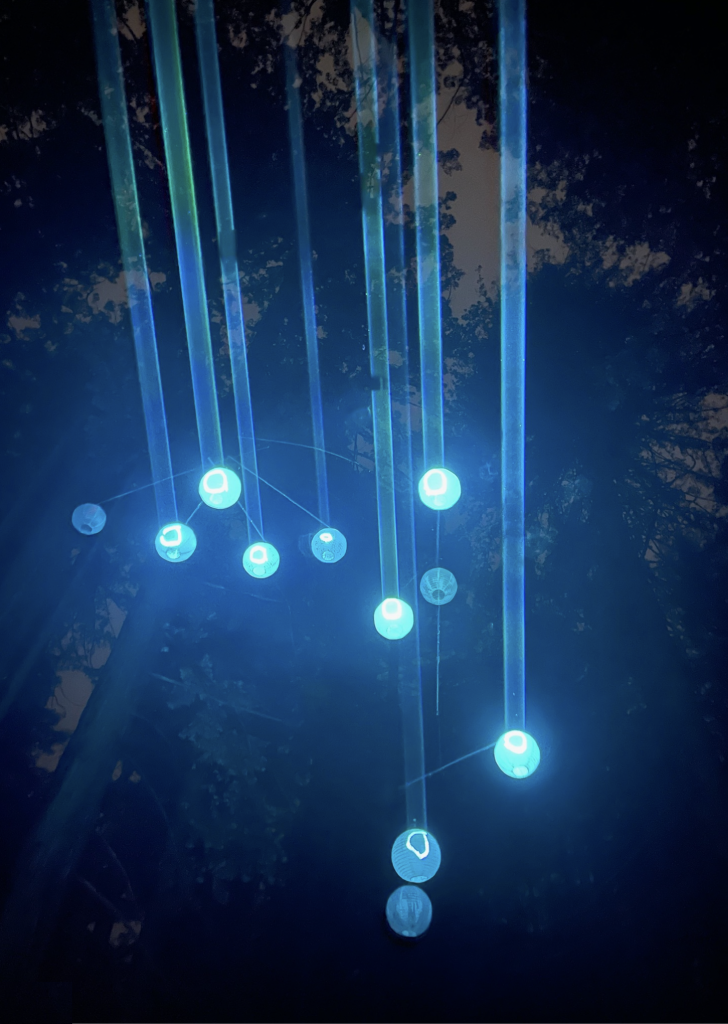
Background and Outcome
This lighting installation was a fever dream by L. that I scrutinized every step of the way. Two weeks of near-daily workshopping by L., J., N., and myself resulted in an installation that was perhaps the most synergistic we’ve ever created together.
Concept: a laser projects onto objects that diffuse light down onto the dance floor. We ended up using IR LEDs inside paper lanterns as the objects, arranged in a traditional calder mobile construction to form a sculpture. On the ground we used a camera with an IR filter, MadMapper, and Resolume to provide visual output to a laser which projected onto the sculpture.
I was first concerned that it would look too contrived as a Calder mobile, then that it wouldn’t sufficiently give a feeling of enclosure to the dance floor, then that it wouldn’t be sufficiently bright, then that the IR camera image wouldn’t have sufficient resolution at a distance of 15-25 feet.
We ended up producing something a lot of people actively complimented during the event (!), and actually if we had tried to incorporate LED bars at all in this installation (50 lbs of gear which I insisted upon bringing as a backup), they would have shorted in the heavy rain we experienced on-site. The rain also produced mist that was perfect for visually highlighting the laser beams as well as diffusing the light across the dance floor.
I still felt that we didn’t dev enough (I had never assembled the mobile at scale, still wasn’t sure how it would look or whether it would output sufficient light) but many points of failure just… didn’t fail, and imo we got lucky with that.
We did a lot of software tweaking during the event that night, which lent a sort of natural progression of complexity through the night that I found fitting:
- Getting the mobile assembled and raised required many extra hands I recruited, and death-defying coordination from our rigger J.;
- Getting the laser mounted correctly upwards at a much more acute angle than we had tested was an arduous physical process spent adjusting the custom tree mount;
- Getting the projection matched perfectly onto the orbs (maybe a 20 min process);
- Getting shaders working with the projection which was failing due to a silly opacity bug in Resolume (in the background, a static color was being projected onto the orbs which still looked very entrancing);
- Finally, the sun rising and removing the IR tracking ability so that the laser’s full throw onto the trees was emphasized for the remaining viewers.

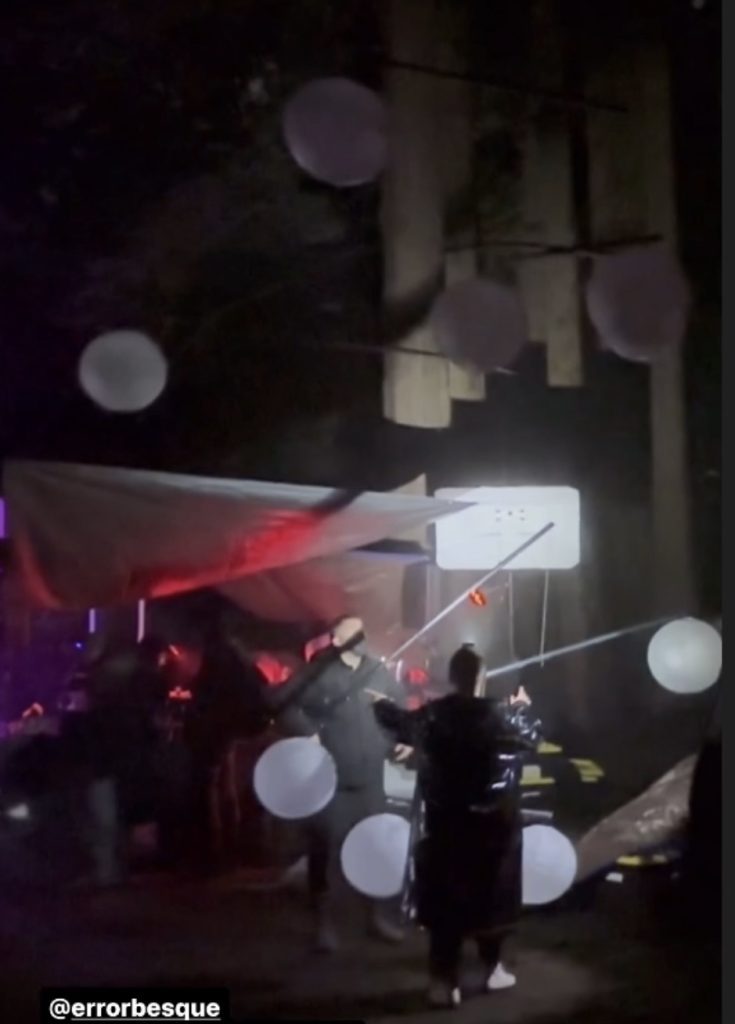
Lantern selection (diffuser and custom parts)
We tested paper lanterns, inflatable PVC balls (matte and glossy), paper lanterns with a secondary layer of PVC on top, and manually-constructed tetrahedra with PVC skin.
The tetrahedra did not sufficiently collect light inside and were the least bright of the objects we tested (more faces within a single hedron would probably have helped this, but we didn’t have enough time to construct so many).
The paper lanterns with a secondary layer of PVC had too much material; light didn’t seem to penetrate through two layers of material as easily and were less bright.
The matte PVC balls we sourced seemed to have the best diffusion properties, but because they were inflatable, mounting the IR LED and required battery in a compact and secure way would be difficult.
I convinced L. that paper lanterns (which we tested to be somewhat waterproof — the paper appeared to be impregnated with a plastic material) were a better aesthetic (being a more natural-looking material contrasted against the forest canopy), and not too much of a compromise on illumination. She 3D-printed a mount for the battery to go inside the lantern that would also protect it from rain.
I also preferred that the bottom hole was open (something only the paper lanterns offered) so that more light would be projected downward onto the dance floor, despite the fact the sculpture seemed more balanced if the weight was on the bottom of the lantern. This (jitter/instability of the orbs) didn’t appear to be an issue in the final implementation.
Camera to laser
L. and J. 3D-printed a mount to get the camera securely attached to the laser. Manual registration would still be required, but in addition to making the hardware easier to manuever, this minimized the amount of shifting that could happen after registration during performance.
The camera had an 850 nm IR filter and used a Computar F1.4 3-8mm 1/3″ CCTV lens.
Laser software
TouchDesigner
TouchDesigner has a promising laser module that N. spent some weeks developing (particularly interested in object-tracking), but that we ultimately didn’t end up using in the final install. (Perhaps a later event!)
Resolume & MadMapper
We eventually used the IR camera input into Resolume as a mask for audio-reactive patterns, and then output to MadMapper (temporary license) for the laser’s final output projection.
Mobile specs
I was at first looking for something a lot more enclosing, particularly something that might hit the back of the dance floor. Realized that based on the constraints of our rigging line this would not work (also that the structure I was planning for the back wouldn’t be able to rotate and might not tolerate wind as well), as well as running out of time, we went for a single large sculpture over the dance floor. I opted for 12 orbs since given the simplicity of the individual pieces, I felt that a large number of orbs would be required to produce interesting visual complexity.
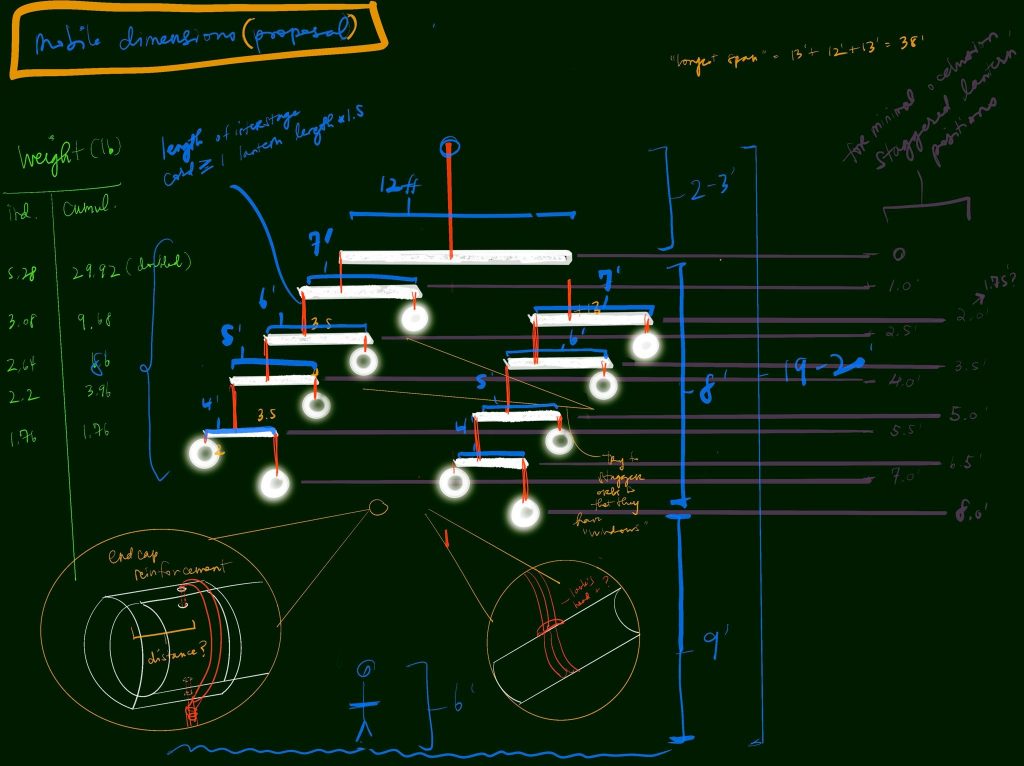
Given that nothing would be “enclosing” the dance floor, I attempted to make the mobile cover as wide a dance floor area as possible. Given the materials constraints of the PVC (max length was 10′), I estimated a maximum spread of 38′, which seemed similar enough to the 45′ circle we had last year. (I would say in actually it was never at “full extension”, and the top pole was so bent that it was more like 8′, but this “worked” for this dance floor, though it definitely didn’t feel as enclosed as I would have liked.)
Rigging (omg, rigging)
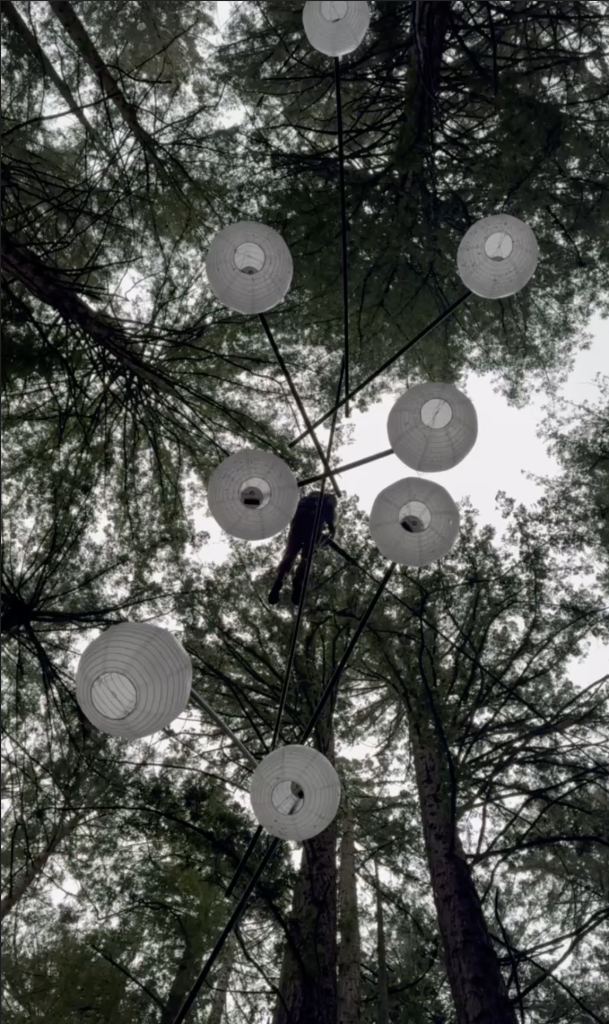
J. spent many days and multiple site visits speccing out the highline attachment and deciding which trees would be ideal for the line. We decided on a single highline where the mobile would be hung from the center on a rotor — J. would set the height manually given my feedback.
We built much of the mobile on-site, in the rain. I recruited G. and C. who both were quite dextrous and in G.’s case, had professional rigging experience. It was a stressful process that took a lot longer than I anticipated — I had pre-cut paracord for every connection, but they were all short for some reason (I’m thinking burning took way more length than I thought), so I had to re-cut everything in the chaos of everyone setting up sound as well.
The attachment of the lanterns to the poles as well as the poles to themselves was a point of major concern given that this was going to be right above the crowd and failure might really hurt someone. I had originally planned to drill holes into the PVC to allay concern for slippage, but became worried that this might weaken them, and knew that there were tension knots that should be suitable for this sort of application.
At G.’s and J.’s recommendations I learned constrictor knots for the first time and used these for all connections of paracord to the poles. I used somerville bowlines for the uplines from the lantern. We had a quick failure on the way up due to an untightened constrictor on one of the bottom poles, but no issues further in the night.
When it was time to pull the sculpture up, J. ascended and came to the center of the highline — the height here was probably 30-40′ or so, so we had lots of headspace. J. pulled the sculpture up manually 1:1 after throwing a paracord line down for me to attach the sculpture’s top line. I added a rotor at this attachment point but I felt the sculpture rotated far less than I anticipated — perhaps due to the extended length and the extremely light weight of the orbs.


